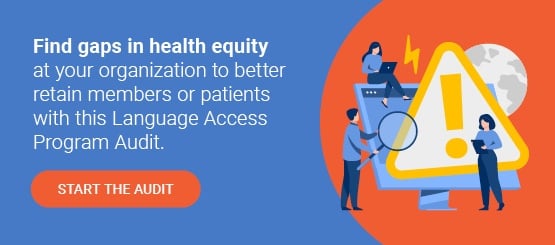A recent analysis by Deloitte found health inequities currently cost the US healthcare industry $312 billion a year, which could balloon to $1 trillion by 2040 if left unaddressed. Key industry stakeholders, such as healthcare providers, cannot afford the rising cost of inequity.
What can providers do to improve health equity—decreasing unnecessary spending and increasing population wellbeing?
The answer is that improving health equity is a process. Providers first must cultivate an in-depth understanding of the populations experiencing health inequity. Then they can remodel products and services around more equitable practices, prioritize early detection and prevention, build community trust, and create partnerships with other stakeholders. Throughout the process, providers can rely on language solution partners for the localization, translation, and interpretation services necessary to make their efforts successful.
Why is health inequity so expensive?
The main reason behind the cost of health inequity is the lack of access to early diagnosis and treatment for common conditions, such as asthma, high blood pressure, mental health care, and diabetes. Late diagnoses mean delayed treatment, increasing the possibility of patients developing costly comorbidities and needing expensive emergency care. In contrast, early detection and treatment help patients manage their conditions, keeping costs low for providers and improving patients’ quality of life.
A compelling example of the cost of late diagnosis is diabetes in the US Black adult population. Although Black adults are 60% more likely to have diabetes than White adults, they often find out late in disease progression and have trouble accessing treatment and medications. Lack of care leads to costly comorbidities and expensive emergency treatment—culminating in over $15 billion in unnecessary spending and the immeasurable cost to individual and community health and wellbeing.
How healthcare providers can address health inequity
Start with a conversation
Successfully tackling inequity in healthcare starts with an in-depth understanding of affected populations and the barriers they may face in accessing care. The most effective way to do this is by talking directly with those impacted by health inequity. Language solutions providers offer localization services that can connect providers directly with community leaders to understand the root causes of health inequities and get feedback from affected populations.
.
A deep understanding of cultural and linguistic barriers to care will help providers tailor their approach and get real results from efforts towards more equitable services and products.
Evaluate existing products and services
After conducting comprehensive research, providers can move toward more equitable care by evaluating the equity of existing products and services for their target populations. Some questions to consider:
- Can everyone afford and access your services?
- Do support teams have the linguistic and cultural training they need?
- How does your target population learn about your services? How can you reach them more effectively?
- Do you include all demographics when testing your products and services?
For a real-life example of how to reach new populations, read United Language Group’s case study on helping a key industry stakeholder develop and enact an effective community engagement strategy—increasing engagement of their target population by 83%.
Prioritize early disease detection and prevention
Since late diagnoses lead to expensive care, improving early disease detection (or preventing diseases altogether) can help providers reduce unnecessary costs. Providers could create new products or services to detect and treat diseases earlier or focus on improving existing processes to reduce socioeconomic health disparities. For example, providers could include culturally-appropriate screening tools in physicals or create a marketing campaign promoting regular checkups and increasing awareness of the signs and symptoms of diseases.
Build trust through communication
Another way providers can address health inequity is by incorporating feedback from target populations about their products and services. Open communication channels between providers and target populations help ensure services continue to be equitable. Communication also improves trust.
Partner with key stakeholders
Eliminating health inequity requires a wide-ranging approach. For example, nonmedical issues, such as lack of housing or resources, also decrease health equity. Providers can make equitable practices more successful and sustainable by partnering with community organizations and other key stakeholders, like payers and government organizations.
Taking steps to provide more equitable services will save money and improve lives. Providers can move towards more equitable care by understanding the unique needs of affected populations, tailoring their services to fit, and forging partnerships.
Want to learn more about how localization, translation, and interpretation experts can help you improve health equity? Contact ULG today.



